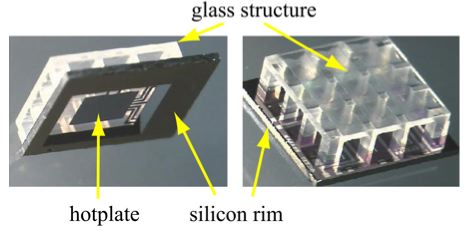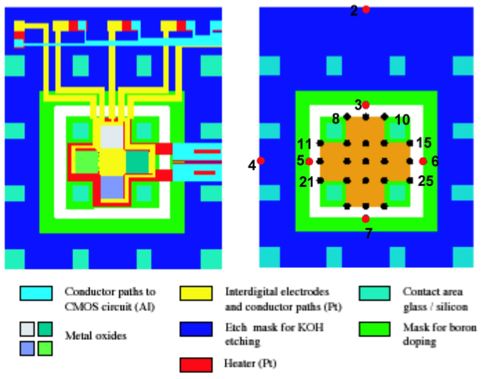| Background | |
|---|---|
| Benchmark ID |
gasSensor_n66917m1q28 |
| Category |
oberwolfach |
| System-Class |
LTI-FOS |
| Parameters | |
| nstates |
66917
|
| ninputs |
1 |
| noutputs |
28 |
| nparameters |
0 |
| components |
A, B, C, E |
| Copyright | |
| License |
NA |
| Creator | |
| Editor | |
| Location | |
|
NA | |
Description: Microhotplate Gas Sensor
The goal of European project Glassgas (IST-99-19003) was to develop a novel metal oxide low power microhotplate gas sensor [1]. In order to assure a robust design and good thermal isolation of the membrane from the surrounding wafer, the silicon microhotplate is supported by glass pillars emanating from a glass cap above the silicon wafer, as shown in Fig. 1. In this design, four different sensitive layers can be deposited on the membrane. The thermal management of a microhotplate gas sensor is of crucial importance.
The benchmark contains a thermal model of a single gas sensor device with three main components: a silicon rim, a silicon hotplate and glass structure [2]. It allows us to simulate important thermal issues, such as the homogeneous temperature distribution over gas sensitive regions or thermal decoupling between the hotplate and the silicon rim. The original model is the heat transfer partial differential equation.
The device solid model has been made and then meshed and discretized in ANSYS 6.1 by means of the finite element method (SOLID70 elements were used).
It contains 68000 elements and 73955 nodes.
Material properties were considered as temperature independent.
Temperature is assumed to be in degree Celsius with the initial state of  .
The Dirichlet boundary conditions of
.
The Dirichlet boundary conditions of  is applied at the top and bottom of the chip (at 7038 nodes).
is applied at the top and bottom of the chip (at 7038 nodes).
The output nodes are described in Table 1.
In Fig. 2 the red marked nodes are positioned on the silicon rim.
Their temperature should be close to the initial temperature in the case of good thermal decoupling between the membrane and the silicon rim.
The black marked nodes are placed on the sensitive layers above the heater and are numbered from left to right row by row, as schematically shown in Fig 2.
They allow us to prove whether the temperature distribution over the gas sensitive layers is homogeneous (maximum difference of  is allowed by design).
is allowed by design).
| Number | Code | Comment |
| 1 | aHeater | within a heater, to be used for nonlinear input |
| 2-7 | SiRim1 to SiRim7 | silicon rim |
| 8-28 | Memb1 to Memb21 | gas sensitive layer |
The benchmark contains a constant load vector.
The input function equal to  corresponds to the constant input power of
corresponds to the constant input power of  .
One can insert a weak input nonlinearity related to the dependence of heater's resistivity on temperature given as:
.
One can insert a weak input nonlinearity related to the dependence of heater's resistivity on temperature given as:
where  .
To this end, one has to multiply the load vector by a function:
.
To this end, one has to multiply the load vector by a function:
where  is a desired constant voltage.
The temperature in the equation above should be replaced by the temperature at the input 1 (aHeater).
is a desired constant voltage.
The temperature in the equation above should be replaced by the temperature at the input 1 (aHeater).
The linear ordinary differential equations of the first order are written as:
where  and
and  are the symmetric sparse system matrices (heat capacity and heat conductivity matrix),
are the symmetric sparse system matrices (heat capacity and heat conductivity matrix),  is the load vector,
is the load vector,  is the output matrix, and
is the output matrix, and  is the vector of unknown temperatures.
The dimension of the system is
is the vector of unknown temperatures.
The dimension of the system is  , the number of nonzero elements in matrix
, the number of nonzero elements in matrix  is
is  , in matrix
, in matrix  is
is  .
.
The outputs of the transient simulation at output 18 (Memb11) over the rise time of the device of  for the original linear (with constant input power of
for the original linear (with constant input power of  ) and nonlinear (with constant voltage of
) and nonlinear (with constant voltage of  ) model are placed in files LinearResults and NonlinearResults respectively.
The results can be used to compare the solution of a reduced model with the original one.
The time integration has been performed in ANSYS with accuracy of about
) model are placed in files LinearResults and NonlinearResults respectively.
The results can be used to compare the solution of a reduced model with the original one.
The time integration has been performed in ANSYS with accuracy of about  .
The results are given as matrices where the first row is made of times, the second of the temperatures.
.
The results are given as matrices where the first row is made of times, the second of the temperatures.
More information can also be found in [3].
Data
Download matrices in the Matrix Market format: GasSensor-dim1e5-GasSensor.tar.gz, (8 MB).
The matrix name is used as an extension of the matrix file. File *.C names contains a list of output names written consecutively. The system matrices have been extracted from ANSYS models by means of mor4fem.
The discussion of electro-thermal modeling related to the benchmark including the nonlinear input function can be found in [4].
Origin
This benchmark is part of the Oberwolfach Benchmark Collection[5]; No. 38880, see [6].
Dimensions
System structure:
System dimensions:
 ,
,
 ,
,
 ,
,
 .
.
Citation
To cite this benchmark, use the following references:
- For the benchmark itself and its data:
- The MORwiki Community, Gas Sensor. MORwiki - Model Order Reduction Wiki, 2018. http://modelreduction.org/index.php/Gas_Sensor
@MISC{morwiki_gas,
author = {{The MORwiki Community}},
title = {Gas Sensor},
howpublished = {{MORwiki} -- Model Order Reduction Wiki},
url = {http://modelreduction.org/index.php/Gas_Sensor},
year = {20XX}
}
- For the background on the benchmark:
@INPROCEEDINGS{BecHWetal04,
author = {T. Bechtold, J. Hildenbrand, J. Wöllenstein, J. G. Korvink},
title = {Model Order Reduction of 3D Electro-Thermal Model for a Novel, Micromachined Hotplate Gas Sensor},
booktitle = {Proceedings of 5th International Conference on Thermal and Mechanical Simulation and Experiments in Microelectronics and Microsystems},
pages = {263--267},
year = {2004},
doi = {10.1109/ESIME.2004.1304049}
}
References
- ↑ J. Wöllenstein, H. Böttner, J.A. Pláza, C. Carné, Y. Min, H.L. Tuller, A novel single chip thin film metal oxide array, Sensors and Actuators B: Chemical 93 (1-3): 350--355, 2003.
- ↑ J. Hildenbrand, Simulation and Characterisation of a Gas sensor and Preparation for Model Order Reduction, Diploma Thesis, University of Freiburg, Germany, 2003.
- ↑ T. Bechtold, "Model Order Reduction of Electro-Thermal MEMS", PhD thesis, Department of Microsystems Engineering, University of Freiburg, 2005.
- ↑ T. Bechtold, J. Hildenbrand, J. Wöllenstein, J. G. Korvink, Model Order Reduction of 3D Electro-Thermal Model for a Novel, Micromachined Hotplate Gas Sensor, Proceedings of 5th International Conference on Thermal and Mechanical Simulation and Experiments in Microelectronics and Microsystems, EUROSIME2004, May 10-12, 2004, Brussels, Belgium: 263--267, 2004.
- ↑ J.G. Korvink, E.B. Rudnyi, Oberwolfach Benchmark Collection, Dimension Reduction of Large-Scale Systems, Lecture Notes in Computational Science and Engineering, vol 45: 311--315, 2005.
- ↑ Hildenbrand J., Bechtold T., J. Wöllenstein, Microhotplate Gas Sensor. In: Dimension Reduction of Large-Scale Systems. Lecture Notes in Computational Science and Engineering, vol 45: 333-336, 2005.






